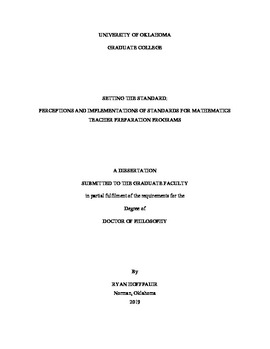| dc.description.abstract | The development and use of standards have become a key aspect of education.
Significant research has been conducted to understand the perceptions and implementations of standards in PK-12 school settings. There exists significantly less research focused on the understanding of standards for teacher preparation, especially within the field of mathematics teacher preparation.
In the field of mathematics teacher preparation, multiple standards documents are
available to inform practice. Among these include the standards used for accreditation purposes produced by the National Council of Teachers of Mathematics (NCTM) in partnership with the Council for the Accreditation of Educator Preparation (CAEP), the Standards for Preparing Teachers of Mathematics produced by the Association of Mathematics Teacher Educators (AMTE), and the Mathematical Education of Teachers (MET) documents produced by the Conference Board of the Mathematical Sciences (CBMS). While these represent the most well-known standards for mathematics teacher educators, other standards such as standards for PK-12 teachers including the Common Core State Standards are also related to the work of mathematics teacher preparation. In this complicated space of multiple standards from multiple perspectives, it is necessary to better understand the influence of these standards with mathematics teacher educators by better understanding how they are perceived and implemented.
In this case study, eight mathematics teacher educators shared how they perceived and
implemented standards within their programs. The findings of this research included navigating standards, standards as tools of accountability and compliance, the intersection of standards and curriculum, collaborating for enacting the standards, and care for students and their experiences. In these findings, participants shared how standards related to ideas of best practice. These ideas about standards being drawn from ideas of best practice are related to issues of compliance in accreditation as well as an indirect correlation with curriculum choices in program development
and maintenance. In practice, this work was not done in isolation, but required interdepartmental collaboration as well as consideration for the needs of individual students.
Keywords: Teacher Education, Standards, Mathematics, Accreditation | en_US |

